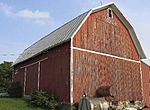Barn facts for kids
A barn is an important building often seen on a farm. Farmers use barns for many different things. They can be a safe home for livestock like horses, cows, or sheep. Barns also store important things like grain (which is food for animals or people) and farm tools or machines.
Contents
What is a Barn For?
Barns are super useful buildings on a farm. They help farmers keep their animals safe and warm, especially during bad weather. They also protect valuable crops and equipment from the rain, snow, and sun.
Keeping Animals Safe
Many barns are built to house farm animals. This means animals like cows, horses, pigs, and chickens can live inside. Barns give them shelter from cold winters or hot summers. They also protect animals from predators. Inside, barns often have stalls or pens where each animal can have its own space.
Storing Crops and Supplies
Barns are also perfect for storing crops after they are harvested. This could be hay for animals to eat, or grains like corn and wheat. Keeping crops dry and safe in a barn helps them last longer. Farmers also store their tractors, plows, and other tools in barns to keep them in good condition.
Different Kinds of Barns
Over time, people have built many different types of barns. The way a barn looks often depends on what it's used for and where it is in the world.
Building Materials
Barns are built using many different materials. In some places, barns are made mostly of wood, like big timber frames. Others might use stone or brick, especially in areas where these materials are common. Some modern barns use metal siding. The materials chosen often depend on what is available nearby and what works best for the local weather.
Barn Styles Around the World
You can see many unique barn styles if you travel! For example, some old barns in Europe have half-timbered walls, which means they use a wooden frame with other materials like brick or stone filling the spaces. In some parts of the United States, you might see round barns, which were thought to be more efficient. In Asia, some traditional barns are built specifically for storing rice. Each style is designed to fit the needs of the farmers and the local environment.
History of Barns
Barns have been around for a very long time, helping farmers for centuries. Early barns were often simple structures, sometimes just a roof supported by posts. As farming methods changed, so did barns. For example, when farmers started using more machines, barns became larger to hold bigger equipment. Today, barns are still a vital part of farming all over the world.
Images for kids
-
The Texas Technological College Dairy Barn in Lubbock, Texas, U.S., was used as a teaching facility until 1967.
-
Russian women using a hand powered winnowing machine in a threshing barn. Note the board across the doorway to prevent grain from spilling out of the barn, this is the origin of the term threshold. Painting from 1894 by Klavdy Lebedev titled the floor or the threshing floor (Гумно).
-
Grange Barn, Coggeshall, England, originally part of the Cistercian monastery of Coggeshall. Dendrochronologically dated from 1237 to 1269, it was restored in the 1980s by the Coggeshall Grange Barn Trust, Braintree District Council and Essex County Council.
-
A barn in southern Ontario, Canada
-
A barn of the Uster castle in the city of Uster, Switzerland
-
This barn in Thuringia, Germany has two outshots forming the recess to the middle barn doors.
-
Traditional Sasak rice barn in village of Sade, Lombok, Indonesia.
-
The barn at Bjärka-Säby Castle, Sweden, around 1909.
-
Half-timbered barn with brick infill. Uetersen, Germany. This barn's proportions resemble a Low German house.
-
Half-timbered with wattle-work walls for ventilation. Stryd Lydan Barn, originally at Llannerch Banna, Flintshire, North Wales. Re-erected at the St Fagans National History Museum, Cardiff, Wales in 1951.
-
Old hay barn at the end of Suitsu hiking trail at the Matsalu National Park in Pärnu County, Estonia.
-
A barn (ovin) in the museum-estate of Surikov. Krasnoyarsk, Russia.
-
A barn (ovin) from Vakhonkino village, Kaduysky raion, Vologda oblast, Russia. Vitoslavlitsy museum, Veliky Novgorod.
-
A rare half-timbered barn with board infill in Syke, Lower Saxony, Germany.
-
Grange barn, Coggeshall, England. This is a studded barn so the wall sheathing must be applied horizontally and covered with a siding material in this case clapboards (weatherboards).
-
Timber framed with the sheathing covered in clapboards. New Hampshire, U.S.A.
-
Rare walls of boards and thatch. Drenthe, Netherlands
-
Hewn log barn painted red in Hedemora, Sweden.
See also
 In Spanish: Cobertizo para niños
In Spanish: Cobertizo para niños








































